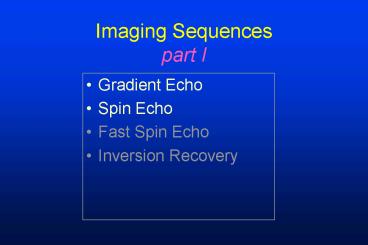Imaging Sequences part I - PowerPoint PPT Presentation
1 / 47
Title:
Imaging Sequences part I
Description:
gradient echo imaging cannot recover signal losses from. magnetic field inhomogeneity ... MR signal is a composite of fat and water in the imaging voxel ... – PowerPoint PPT presentation
Number of Views:114
Avg rating:3.0/5.0
Title: Imaging Sequences part I
1
Imaging Sequencespart I
- Gradient Echo
- Spin Echo
- Fast Spin Echo
- Inversion Recovery
2
Goals of Imaging Sequences
- generate an RF signal perpendicular to ?0
- generate tissue contrast
- minimize artifacts
3
Measuring the MR Signal
RF signal from precessing protons
RF antenna
4
Gradient Echo
- simplest sequence
- alpha flip-gradient recalled echo
- 3 parameters
- TR
- TE
- flip angle
- reduced SAR
- artifact prone
5
Gradient Echo
dephase
gradient
rephase
signal
FID
gradient recalled echo
? RF pulse
6
Partial Flip
?0
ML
M
MXY
tt0
tt0
MXY M sin(?)
ML M cos(?)
7
Dephasing in the xy-planeview from the top
Mxy??
dephase
Mxy
phase coherency
phase dispersion
8
Rephasing in the xy-planeview from the top
rephase
9
MR Signal During Rephasing
RF signal echo
RF antenna
10
T2 decay
- occurs between the dephasing and the rephasing
gradients - rephasing incompletely recovers the signal
- signal loss is greater with longer TEs
- decay generates image contrast
11
T2 decay
- T2 decay is always faster than T2 decay
- gradient echo imaging cannot recover signal
losses from - magnetic field inhomogeneity
- magnetic susceptibility
- water-fat incoherence
12
T2 and T2 Relaxation
- T2 is the spin-spin relaxation time
- T2M is the contribution to relaxation induced by
inhomogeneities of the main magnet (predominant
factor) - T2MS is the contribution to relaxation induced by
magnetic susceptibility in the object
13
T2 and T2 Relaxation
- T2 relaxation influences contrast in gradient
echo imaging - T2 relaxation influences contrast in spin echo
imaging
14
Gradient Echopulse timing
??
RF
slice
phase
readout
echo
signal
TE
15
Gradient Echoadvantages
- faster imaging
- can use shorter TR and shorter TEs than SE
- low flip angle deposits less energy
- more slices per TR than SE
- decreases SAR
- compatible with 3D acquisitions
16
Gradient Echodisadvantages
- difficult to generate good T2 weighting
- magnetic field inhomogeneities cause signal loss
- worse with increasing TE times
- susceptibility effects
- dephasing of water and fat protons
17
Gradient Echochanging TE
TE 9 FA 30
TE 30 FA 30
susceptibility effect
T2 weighting
18
Gradient Echomagnetic susceptibility
post-surgical change blooming artifact
19
Gradient Echoin-phase / opposed-phase
TE 13.42
TE 15.66
in-phase
opposed-phase
20
Water/Fat Dephasing
- MR signal is a composite of fat and water in the
imaging voxel - water and fat resonate at slightly different
frequencies - cyclic variation in relative phase of fat and
water resonance results in signal variations
dependent on TE times
21
(No Transcript)
22
In-Phase / Opposed-Phase TE Times (msec)
23
Gradient Echo
- image contrast depends on sequence
- conventional GR scan
- aka GRASS, FAST
- decreased FA causes less T1 weighting
- increased TE causes more T2 weighting
24
Conventional GRTE 20, FA 15
25
Gradient Echo
- Spoiled GR
- aka SPGR, RF-FAST
- spoiling destroys accumulated transverse
coherence - maximizes T1 contrast
26
Gradient Echo
- Contrast enhanced GR
- aka SSFP, CE-FAST
- infrequently used because of poor S/N
- generates heavily T2 weighted images
27
Gradient Echo
- other varieties
- MTC
- T2 - like weighting
- IR prepped
- 180 preparatory pulse
- DE (driven equilibrium) prepped
- 90-180-90 preparatory pulses
- T2 contrast
28
MTC GRTE 13, FA 50
29
Spin Echo
- widely used sequence
- 90-180-echo
- 2 parameters
- TR
- TE
- generates T1, PD, and T2 weighted images
- minimizes artifacts
30
Spin Echo
gradient
readout
frequency encode
??? RF pulse
???? RF pulse
signal
FID
spin echo
31
Gradient versus Spin Echo
32
900 Flip
??0
After ML0 MXYM
Before MLM MXY0
tt0
tt0
33
Dephasing in the xy-planeview from the top
Dephasing begins immediately after the 900 RF
pulse.
Mxy??
Mxy
phase coherency
phase dispersion
900 RF
t0
tTE/2
34
Rephasing in the xy-planeview from the top
1800 RF
35
1800 Flip
dephased
rephased
1800 RF
900 RF
tTE/2
tTE
t0
36
Spin Echopulse timing
???
????
RF
slice
phase
readout
echo
signal
TE
37
WNMR Race
900 RF
t0
38
WNMR Race
39
WNMR Race
1800 RF
tTE/2
40
WNMR Race
tTE
41
Effects of the 1800 Pulse
- eliminates signal loss due to field
inhomogeneities - eliminates signal loss due to susceptibility
effects - eliminates signal loss due to water/fat dephasing
- all signal decay is caused by T2 relaxation only
42
Spin Echoadvantages
- high signal to noise
- least artifact prone sequence
- contrast mechanisms easier to understand
43
Spin Echodisadvantages
- high SAR than gradient echo because of 900 and
1800 RF pulses - long TR times are incompatible with 3D
acquisitions
44
Spin Echo Contrast
- T1 weighted
- short TR (450-850)
- short TE (10-30)
- T2 weighted
- long TR (2000 )
- long TE (gt 60)
- PD weighted
- long TR, short TE
45
Spin Echo Contrast
- T1 weighted - T1 relaxation predominates
- Short TE minimizes differences in T2 relaxation
- Short TR maximizes differences in T1 relaxation
- T2 weighted - T2 relaxation predominates
- Long TE maximizes differences in T2 relaxation
- Long TR minimizes differences in T1 relaxation
46
Spin Echo Contrast
T1 weighted
T2 weighted
47
Spin Echo Contrast
PD weighted
T2 weighted





























![[Part 2] Automation of Home Appliances using Raspberry Pi – Implementation of Hand Gesture Recognition PowerPoint PPT Presentation](https://s3.amazonaws.com/images.powershow.com/8848020.th0.jpg?_=20170531063)

